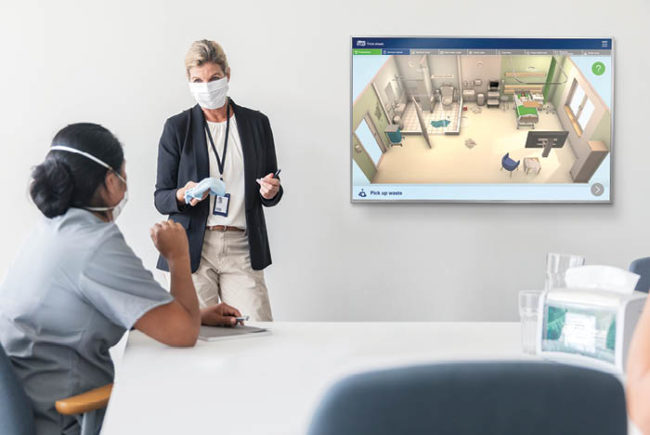Disinfecting health care environments always has been a significant challenge, and these days the task has become even more daunting as new, stronger pathogens emerge. In response, manufacturers have developed fast-acting, easy-to-apply disinfectants that kill a variety of bacteria and viruses and reduce the risk of cross-contamination. As new challenges arise, development of new formulas continues.
Preventing the spread of Clostridium difficile is especially difficult because its spores are resistant to standard disinfectants and can live on hard surfaces for months. According to a study published in the JAMA Internal Medicine, C. difficile infections cost the health care industry $1.5 billion each year.
You may also like |
| Essential steps to stop Clostridium difficile |
| Automated UV and HP disinfection systems |
| Optimize your cleaning practices |
| |
What’s more, the recent Ebola scare has prompted hospitals to take a closer look at their disinfectant products and cleaning processes. “[Centers for Disease Control and Prevention (CDC)] guidelines specify that hospitals use Environmental Protection Agency (EPA)-registered disinfectants that have label claims for non-envelope viruses — the thought being: If you can kill this type of organism, it will be effective against Ebola,” says Dan Klein, senior manager, microbiology, science and technology, Steris Corp., Healthcare Group, Mentor, Ohio.
“Ebola aside, Middle East Respiratory Syndrome, carbapenem-resistant enterobacteriaceae, Enterovirus and other organisms are forcing hospitals to seek the most up-to-date products with the highest kill rates,” Klein continues. “One challenge is to consistently test for the most recent harmful organisms and provide adequate documentation for it.”
Clean evaluation
Health care facilities are re-evaluating not only their disinfectant products, but also the disinfection process itself to ensure that it is compliant with current evidence-based CDC recommendations. “It is important that health care facilities closely follow CDC recommendations for disinfection of the health care environment for patients with suspected or confirmed Ebola virus disease and/or Enterovirus, and use an EPA-registered, hospital-grade disinfectant with specific efficacy claims for non-enveloped viruses,” says J. Hudson Garrett Jr., vice president, clinical affairs, PDI Inc., Orangeburg, N.Y.
Disinfectants need to meet three core criteria. They must be efficacious and broad-spectrum with antimicrobial activity against a variety of pathogenic bacteria, viruses, pathogenic fungi and bloodborne pathogens. They must be safe for the user, patient and environment. They also must be compatible with the environmental surfaces and medical devices commonly used in a health care setting, according to Garrett.
Disinfectants should be fast-acting and effective in the presence of organic matter such as blood, have an acceptable odor profile, be stable and water-soluble, adds Sarah C. Bell-West, senior scientist in research and development, Clorox Professional Products Co., Pleasanton, Calif. “Ideally, products should clean and disinfect in one step and be available in multiple formats such as wipes, sprays and pull tops,” she explains. “Other disinfectant selection factors include training and support offered by the manufacturer, costs and standardization.”
All disinfectant claims must be registered by the EPA, adds Cali Sartor, director of marketing, Spartan Chemical Co., Maumee, Ohio. The EPA requires independent lab testing for each organism to determine the efficacy to disinfect and the time required to do so. “Because housekeeping staff must turn rooms over quickly, it is important that they be trained on cleaning methods and have well-documented procedures in order for the disinfectants to work properly,” Sartor says.
The trend toward fast-acting products is being driven by a desire to improve compliance when cleaning and disinfecting, according to Andrew Rushworth, global portfolio lead, hard surface infection prevention, Sealed Air Diversey Care, Charlotte, N.C. One example, he notes, is Diversey Care’s Oxivir TB, which uses a one-minute contact time based on accelerated hydrogen peroxide technology. This ensures that the surface remains wet for the duration of the contact time.
Wiping it clean
Just 10 years ago, the use of pre-saturated disinfectant wipes was not a common practice in the health care industry, according to manufacturers that supply the nation’s hospitals. Today, most facilities rely on these types of products to help curb the spread of infections due to their efficacy, fast kill times and ease of use. A pre-saturated, ready-to-use wipe eliminates the need to apply the facility’s disinfectant to the microfiber. It also ensures uniform delivery of the disinfectant to the treated surface.
“Also, the market is seeing an increase in different sizes of wipes for different applications — wipes for clinical staff being smaller at around 40 to 45 square inches, while those for environmental services teams tend to be as much as three times larger at 130 to 145 square inches. Diversey offers premoistened wipes in larger and smaller sizes, as well as a smaller-count bullet pack,” says Rushworth.
One of the latest developments in wipes is the use of hybrid-forming processes, according to Michael Kupneski, research and development section head, P&G Professional, Costa Mesa, Calif. “Typically, the performance of a wipe is driven largely by its fiber content as well as the process that formed it,” he says. “Manufacturers of hybrid wipes are trying to extend the benefits of different processes into a single wipe.”
Although wipes tend to be more expensive on a per-unit basis than other types of disinfectants, their ready-to-use characteristic can actually shorten the cleaning process. “Concentrated solutions will always deliver the best cost per use. However, ready-to-use products like disinfectant wipes can deliver convenience and lower risk of cross-contamination in high-risk areas,” Sartor notes.
Wipes are cost-effective when used appropriately, but, more importantly, they ensure consistent application to the treated surface, unlike such other solutions as liquids or sprays that rely on the user to apply them correctly, according to Garrett. “Also, pre-saturated wipes are available in a variety of dispensing configurations and can be placed at point-of-care locations,” he says.
Bell-West of Clorox says one recent study showed significant cost savings associated with the ready-to-use wipe system because hospital employees were able to complete their cleaning and disinfection tasks more quickly than with the mop-and-bucket method. “In reality, there are probably even more time savings associated with the ready-to-use system, as the calculation did not account for pre-processing steps involved in the mop-and-bucket method: obtaining cloths and buckets and the time it takes to dilute the product to the proper concentration,” she explains.
“Wipes help to avoid overspray and chemicals getting on equipment that could cause damage,” Klein says. “Steris Coverage Plus germicidal surface wipes provide that level of convenience and are fast-acting, which helps hospital employees to clean and prep a room quickly.”
Clorox Healthcare bleach germicidal wipes are EPA-registered to kill C. difficile spores in three minutes. The wipes offer a solution for daily and terminal cleaning because they are premoistened to consistently deliver the proper concentration of sodium hypochlorite, the sporicidal active ingredient. They also are EPA-registered to kill a variety of bacteria and viruses in one minute or less.
PDI Inc. offers Sani-Cloth AF3 and Sani-Cloth bleach pail products, which facilitate rapid room turnover. Sani-Cloth bleach wipes have a stabilized 1:10 dilution of sodium hypochlorite and are proven effective against 50 microorganisms, including 14 multidrug-resistant organisms with an overall contact time of four minutes. They are designed to kill the most clinically relevant pathogens in health care, including C. difficile spores and Norovirus, the company reports.
Rubbermaid Commercial Products, Winchester, Va., has seen a growing trend in Europe and now in the United States, of disposable microfiber as an alternative to premoistened paper wipes. The company’s Hygen disposable microfiber wipes can be used with a hospital’s cleaning chemical of choice or with water alone. The wipes reportedly offer 99.9 percent microbe removal of such bacteria as C. difficile with water. This allows housekeeping staff to lower chemical usage in certain areas, thus reducing costs.
Sprayable solutions
Comet disinfecting cleaner with bleach from P&G Professional is an EPA-registered, hospital-grade cleaner and disinfectant that combines the cleaning ability of heavy-duty detergents with the stain-removal ability of bleach. It cleans a wide range of tough soils, but contains no abrasives, and kills pathogens such as C. difficile, hepatitis B and influenza A, the company reports.
Ecolab, St. Paul, Minn., offers OxyCide daily disinfectant cleaner, a non-bleach sporicide developed for daily use in health care settings. It can kill a broad spectrum of harmful bacteria and viruses, including C. difficile spores in three minutes and multidrug-resistant organisms and viruses in five minutes or less.
OxyCide leaves no visible residue and does not require rinsing, the company reports. It is noncorrosive on most hard surfaces, including such high-touch objects as overbed tables, bed rails, door handles and bathroom surfaces. In addition, its lockable cabinet and closed-loop dispensing system offer safe product handling for staff, helping to reduce the risk of spills by eliminating the need for manual pouring and mixing.
Protocol guidance
Manufacturers also offer resources to help train staff in the proper use of disinfectant products.
One example is HealthCheck from Spartan Chemical Co., which combines education, training tools and documentation along with disinfectant and cleaning products. Likewise, Clorox Professional Products Co. helps hospitals to train their staff on how to use new products and implement protocols to drive compliant usage. The company also has a team of scientists on staff to help address technical questions. “We provide educational resources on [our website], which include pathogen education fact sheets, infographics and toolkits,” Bell-West notes.
As new challenges emerge, advances in disinfection products and protocols and the resources to use them likely will follow.
Neal Lorenzi is a freelance writer based in Mundelein, Ill.
The cost of Clostridium difficile
According to the Centers for Disease Control and Prevention, there are 500,000 Clostridium difficile infections a year in the United States. Some other statistics associated with C. difficile from the Association for Professionals in Infection Control and Epidemiology include:
$35,000 Average cost for an inpatient with a C. difficile infection
$3 billion Estimated annual cost of C. difficile on the health care system
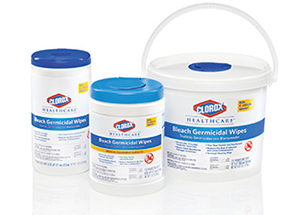 | Right-sizedClorox Healthcare bleach germicidal wipes come in multiple sizes, so environmental services can easily clean and disinfect larger surface areas. |
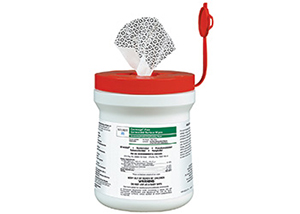 | Always readyCoverage Plus germicidal surface wipes provide a ready-to-use, premeasured disposable cleaning option to fight broad-spectrum biocidal activity, including Mycobacterium tuberculosis and HIV-1. |
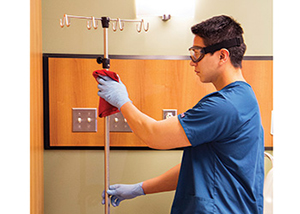 | Full serviceHealthCheck combines education, training tools and documentation along with disinfectant and cleaning products. |
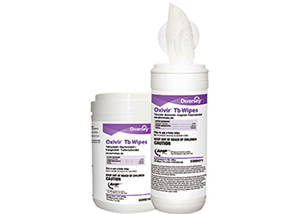 | Close contactThe Oxivir TB product family uses a one-minute contact time based on accelerated hydrogen peroxide technology. |
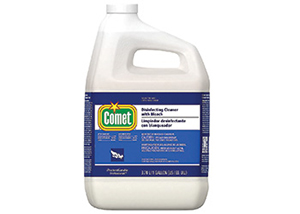 | Double timeComet disinfecting cleaner with bleach combines the cleaning ability of heavy-duty detergents with the stain-removal ability of bleach. |
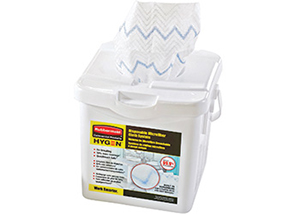 | Flexible systemHygen disposable microfiber cloth system can be used with a hospital’s cleaning chemical of choice or with water alone. |
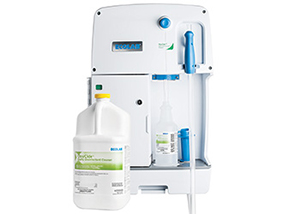 | Safe for useOxycide’s noncorrosive formulation is safe on high-touch objects such as overbed tables, bed rails, door handles and bathroom surfaces. |
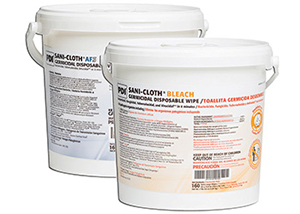 | On callSani-Cloth pail and refill system features 160 premoistened, ready-to-use, extra-large wipes. |



